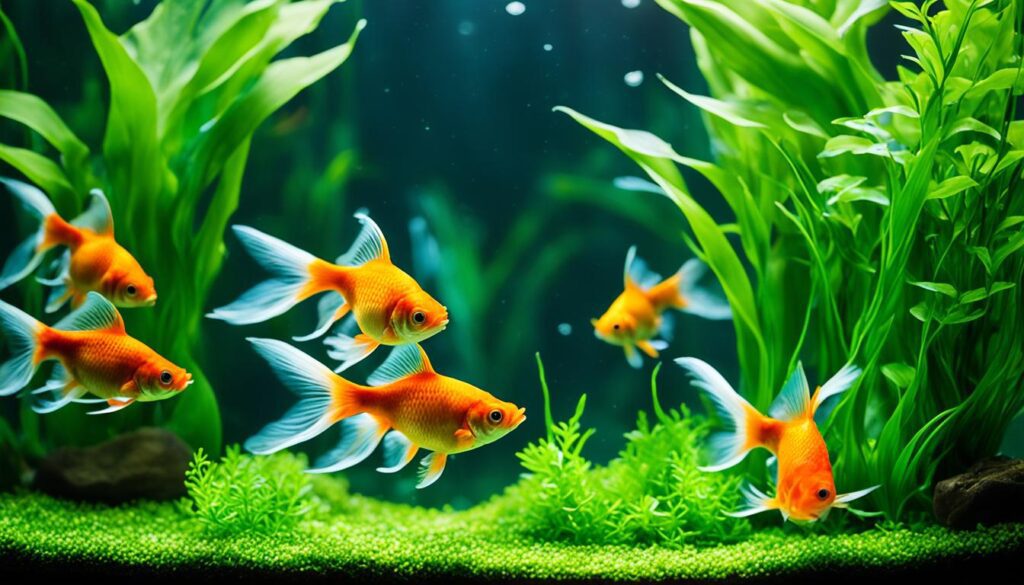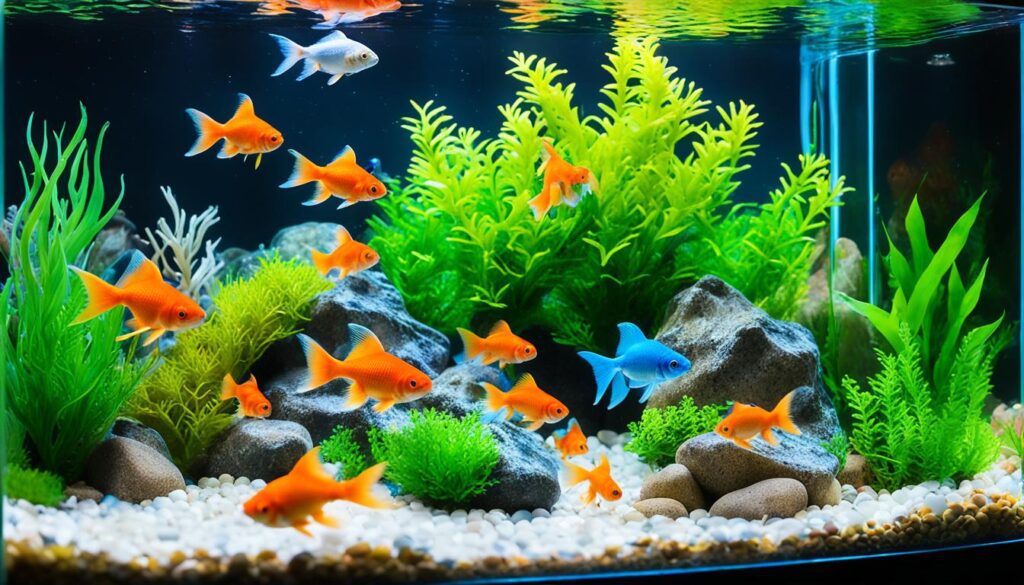I’m all about chatting about goldfish care! These little guys trace their roots back to the calm waters of ancient China, carrying a bit of that old-world peace right into our homes. Setting up the perfect tank for them isn’t just about looks—it’s a way to show how much we care, making sure they stick around to brighten our lives for years to come.
Goldfish need plenty of space and super clean water to really thrive. They can get pretty big—up to 30 cm—and can live for about 20 years if we take good care of them. That means keeping an eye on their diet, their living conditions, and even their tank mates. So, let’s dive into what it takes to keep them happy and healthy for the long haul!
The Lifespan and Growth Potential of Common Goldfish

Goldfish are a top pick for aquarium lovers and pet owners, thanks to their bright colors and playful personalities. But to keep them in tip-top shape, it’s important to understand a bit about their lifespan, how big they can get, and what they need as they grow.
Factors Influencing Goldfish Longevity
Several factors impact the health and life of goldfish. The tank environment is key. A spacious and clean aquarium is essential. With the right care, good space, and clean water, goldfish can live for up to 10-15 years. In ponds, they might even reach their 20s or 30s.
Diet is also very important for goldfish. They need a lot of protein to grow, especially when they are young. Adults need about 6% fat. If their diet isn’t right, their health and lifespan can suffer.
The Misconception of Goldfish Size and Life Expectancy
Many think goldfish only grow as big as their tank. This isn’t true and is harmful. It can stunt their growth and hurt their health. Experts say a 30-gallon tank is minimum for grown goldfish. This allows them to reach their full size.
Realistic Expectations for the Lifespan of Goldfish in Proper Care
Under the best conditions, goldfish can live longer than expected. Checking and keeping the water quality high is vital. The right pH levels and temperature are important. Also, fish need space. Crowded tanks can stress them out and harm their health.
Understanding goldfish’s social needs is part of good care. They like being with other goldfish. This can make them happier and healthier. It helps them grow and live longer.
In summary, goldfish do best when their tank is like their natural habitat. This means enough space, the right food, and regular tank care. With these, they can live a long life and grow big.
Proper Tank Setup for Common Goldfish

Setting up the perfect home for common goldfish goes way beyond just making it look nice. It’s all about keeping them healthy and ensuring they live a long, happy life. We’ll dive into the essential things you need to get right, like picking the right tank size, creating a comfy environment, and making sure you’ve got strong filtration and proper aeration.
Choosing the Right Aquarium Size and Dimensions
Goldfish need space to grow and be healthy, they’re not just for decoration. A single goldfish needs a tank that’s 20 to 30 U.S. gallons (75.7 to 113 liters). Add 15 gallons for every extra goldfish. This space lets them move freely and grow well, which keeps them from getting sick from being too cramped. Bigger tanks also mean cleaner water, which is vital for their health.
Goldfish Specific Needs through Tank Environment
The tank for goldfish should feel like their natural home. This makes them healthy and encourages them to explore. Here’s how to set up a tank with plants:
- Start with Plants: Add plants before the goldfish. This helps plants get strong roots and stops them from being pulled out.
- Substrate Choice: Use quartz gravel or small pea gravel. It’s easy to keep clean and won’t pack down.
- Robust Plant Selection: Pick plants like Giant Vallisneria and Java Fern. They can handle goldfish nibbling and digging.
- Stabilize Young Plants: Anchor new plants with heavy stones or terracotta weights. This keeps goldfish from unrooting them.
Implementing Effective Filtration and Aeration Systems
Goldfish tanks need good filtration and aeration because goldfish make a lot of waste. The filter should have mechanical, chemical, and biological parts and fit the tank’s size. Good aeration helps the water get enough oxygen, which goldfish need to breathe.
Type of Filtration |
Functions |
Suitable for Tank Size |
|---|---|---|
Mechanical |
Traps solid waste |
20-30 gallons |
Chemical |
Removes toxins |
30-55 gallons |
Biological |
Breaks down ammonia |
55+ gallons |
Taking care of goldfish the right way can give them a long, healthy life in a beautiful tank setting. From picking the right tank size, making the tank comfortable, to using the best filters and air systems, every choice is important. All these steps help create a wonderful world for goldfish.
Dietary Considerations for Optimal Common Goldfish Health

Understanding a goldfish’s diet is key to keeping them healthy and lively. They need a varied diet since they eat both plant and animal materials. We will look at how to feed them right, offer feeding tips, and suggest foods to keep them in good shape.
Balancing Nutrients for Growth and Vigor
To keep your goldfish healthy, a well-balanced diet is essential. Sinking pellets are best because they don’t cause swimming issues. Goldfish can eat different foods thanks to their strong stomachs. This variety helps them grow and look brighter. Feed them a teaspoon of pellets or some algae wafers every day without giving them too much.
Common Pitfalls in Goldfish Feeding Practices
Many people feed goldfish based on their eye size, which is not enough food. Check their poop to see if you’re feeding them right. Clear poop means not enough food, and too much means overfeeding. Feeding them twice daily, letting them finish the food in one to two minutes, is ideal. This method keeps both the fish and the water healthy.
Introducing Variety – Safe Live, Frozen, and Vegetable Foods
Different foods are great for goldfish. They love safe live and frozen foods like brine shrimp, daphnia, and krill. Plus, adding veggies like romaine lettuce or peas now and then is good. This diet makes them act more naturally and helps them digest better.
Age |
Expected Size |
Food Type |
Frequency |
|---|---|---|---|
Juvenile |
1-3 inches |
Pellets, Flake Food |
Twice a day |
1-2 years |
3-7 inches |
Pellets, Vegetables |
Twice a day |
Adult |
7-18 inches |
Pellets, Brine Shrimp, Vegetables |
Once or twice a day |
It’s important to watch how your goldfish grows and change their diet as needed. Along with taking care of the tank, a good diet helps your goldfish live a long, healthy life.
Behavioral Traits and Social Requirements of Common Goldfish

Goldfish shine with their bright colors and calm nature. Their behavior shows how much they need friends. They love being with other goldfish, showing the importance of togetherness for a happy tank life.
It’s easy to think fish aren’t social, but goldfish prove us wrong. They stick together, which helps them feel safe and healthy. Being in a group makes them happier and more lively thanks to their friendship bonds.
Knowing about goldfish behavior is key. The right tank setup is crucial for their social life. A big tank gives them the space they need to be healthy. For tips on keeping goldfish, check out this goldfish care guide.
Goldfish communicate in fun ways, like touching fins and swimming side by side. These playful moves are important for their growth and to lower stress. Watching them interact is both interesting and fun.
Goldfish are more than just pets. They teach us about the social life under the water. Giving them the right friends and space makes them healthier and more active. This shows how their surroundings and friends affect their well-being.
Common Goldfish Health and Well-Being
As a devoted fishkeeper, caring for goldfish is essential. It begins with clean water. Keeping ammonia under 0.1 ppm, nitrites below 0.2 ppm, nitrates under 50 ppm, pH between 6.5 and 7.5, and water temperature at 20 to 24°C (68-75°F) prevents diseases. Regularly changing 20% of the tank water each week stops harmful nitrate buildup. This ensures my goldfish stay healthy.
Spotting early signs of trouble keeps my fish well. I act fast when I notice odd behavior or physical changes. This includes less movement, not eating normally, or having spots on their skin. Knowing these signs helps me treat issues early, leading to better recovery chances. It’s also key to remember that each young goldfish needs 10 gallons of space, growing to 20 gallons for adults, and a filter system that cycles 100 gallons of water per hour for every 10 gallons of tank space.
Good nutrition is vital for goldfish health. I feed them only as much as they can eat in 2-3 minutes, once or twice daily. This matches their natural eating habits and prevents overfeeding issues. Social interaction and a well-set environment are also important. Adding plants and controlling light for no more than 10 hours a day helps mimic their natural world, reducing stress. I’ve found goldfish in groups are more active, showing the value of having friends for their health.
When health issues appear, talking to a vet is crucial. They provide specialized care that can extend my goldfish’s lives. Paying attention to everything from tank setup to feeding routines plays a big part in creating a safe, happy home for them. This careful approach has kept my goldfish thriving.








